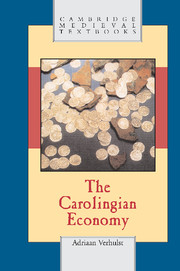3 - Agricultural production
Published online by Cambridge University Press: 05 June 2012
Summary
INTRODUCTION: THE GENERAL SETTING
Carolingian agriculture was, to an extent, practised by free independent peasants, though these had probably been more numerous in the preceding Merovingian period. The discussion in this chapter will concentrate on big landownership because so little is known about free independent peasants compared with what we know about large estates. The Carolingian state, particularly its military organisation, was in principle based upon the existence of a large class of free people, mainly peasants. Gifts of landed property to churches, especially in the eighth and ninth centuries, were often made by free people who ran a peasant farm, sometimes with the help of unfree servants (mancipia). Nearly nothing is known about the size of these farms, which can be supposed to have been diverse. Peasants might have enjoyed rights in the woods, pastures and other uncultivated land belonging to the community whose members they were. The location and composition of this community is a problem, for its relation to the population centre of an organised big estate is not at all clear. Often, independent peasant farms were located near or even in the midst of royal or ecclesiastical manors.
The most widely diffused form of agricultural activity, however, particularly in the Carolingian period, was that of dependent peasants, not totally free and even unfree, within what we call a manor (Lat. villa, or fiscus when in royal hands).
- Type
- Chapter
- Information
- The Carolingian Economy , pp. 31 - 60Publisher: Cambridge University PressPrint publication year: 2002



